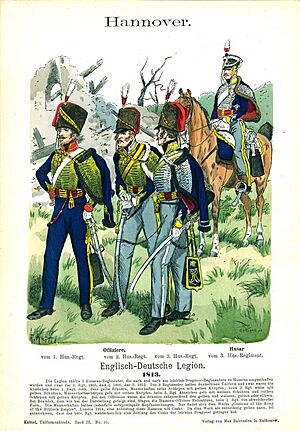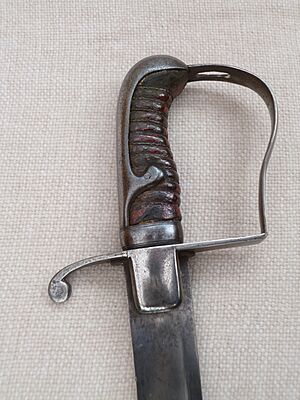Pattern 1796 light cavalry sabre facts for kids
Quick facts for kids Pattern 1796 light cavalry sabre |
|
|---|---|
| Production history | |
| Designer | John Le Marchant/Henry Osborn |
| Designed | 1796 |
| Manufacturer | Various |
| Produced | 1796-1821 |
| Specifications | |
| Length | Blade - 32.5–33 in (83–84 cm) |
|
|
|
| Blade type | Curved, single fuller, asymmetric point. |
| Hilt type | Single knucklebow of "stirrup" type. |
| Scabbard/sheath | Iron, wood liners, 2 loose suspension rings |
The Pattern 1796 light cavalry sabre was a special kind of sword. It was mostly used by British light cavalry soldiers, like light dragoons and hussars, during the Napoleonic Wars. Other countries like Prussia, Portugal, and Spain also used similar swords.
Contents
Why a New Sword?
During the early French Revolutionary Wars, a British Army captain named John Gaspard Le Marchant noticed something important. He saw that the cavalry soldiers weren't very skilled, and their swords (called the 1788 Patterns) were too heavy and long. They were hard to use in battle.
Le Marchant wanted to make things better for the cavalry. He worked with a sword maker from Birmingham, Henry Osborn, to design a new, improved sword. This new sword became known as the Pattern 1796 Light Cavalry Sabre. Le Marchant hoped all British cavalry would use it, but the army decided to give a different, straight sword to the heavy cavalry.
How the Sabre Was Designed
The design of this sabre was inspired by swords from Eastern countries. Le Marchant himself said that blades from places like Turkey and Hungary were better than others. The shape of the blade was similar to some Indian swords called tulwars. This is why some Indian sword makers later put new handles on old 1796 sabre blades.
The Trooper's Sabre
The 1796 sabre had a strong curve. This made it much easier for cavalry soldiers to make slashing attacks while riding. Even French cavalry, who were trained to thrust with their swords, often ended up hacking in the heat of battle. The 1796 sabre was perfect for this.
A special feature of its blade was that it got wider near the tip. This changed the sword's balance but made slashes much more powerful. People have compared its cutting action to a modern bacon slicer! It's even said that French officers complained about how brutal this design was, but we don't know for sure.
The blade was about 32.5 to 33 inches (82.5 to 84 cm) long. It had a single wide groove, called a fuller, on each side. This sabre was lighter and easier to handle than the heavy cavalry sword of the same period, the 1796 Heavy Cavalry Sword.
The handle, or hilt, was simple and light. It had a single iron bar to protect the hand. This design made the sabre easy for any cavalryman to use, not just the strongest ones. A typical trooper's sabre weighed about 2 pounds, 2 ounces (0.96 kg). The handle was made of ridged wood covered in leather. The sword was carried in an iron scabbard (sheath) with wooden liners. It hung from the waist using two loose rings.
Officers' Sabres
Officers also carried fighting swords that looked very much like the troopers' versions. However, officers' sabres were usually lighter, weighing about 1 pound, 13 ounces (0.83 kg). They also showed better craftsmanship and a finer finish.
The handles of officers' swords were often wrapped with silver or brass wire. The back part of the grip had smaller decorative pieces, or sometimes none at all. Officers serving in India sometimes had their sword handles and scabbards covered in silver. This helped protect them from the high humidity during the Monsoon season.
Unlike heavy cavalry officers, light cavalry officers didn't have a specific dress sword. This meant many officers bought swords that looked like the 1796 pattern but had a lot of fancy decorations. These could include blades with blue and gold designs or hilts made of gilt-bronze. Some very showy swords even had ivory handles and lion's-head pommels (the knob at the end of the handle). These fancy swords were mostly for show, not for battle.
After 1800, officers also started to like 'Mameluke-hilted' sabres. These were either real Turkish kilij swords or copies of them. They became popular for officers to wear when dressed up for formal occasions.
How the Sabre Was Used

British cavalry training focused on using the sabre to cut. Soldiers were taught to aim for the face to injure or kill, or for the arms to disable an enemy.
The Sabre's Legacy
The 1796 sabre is still remembered today as one of the best swords of its time. Some experts call it the finest cutting sword ever made in large numbers. Officers from famous regiments like the 95th Rifles and other light infantry units also used swords with the same handle design as the 1796 light cavalry sabre, but with a lighter and shorter blade.
The Prussians copied this sabre, and some German soldiers even used very similar swords in the First World War. The Americans also created a sword design that was directly influenced by the British 1796 sabre.
See also
- Pattern 1796 infantry officer's sword
- Hussar szabla
- Kilij




